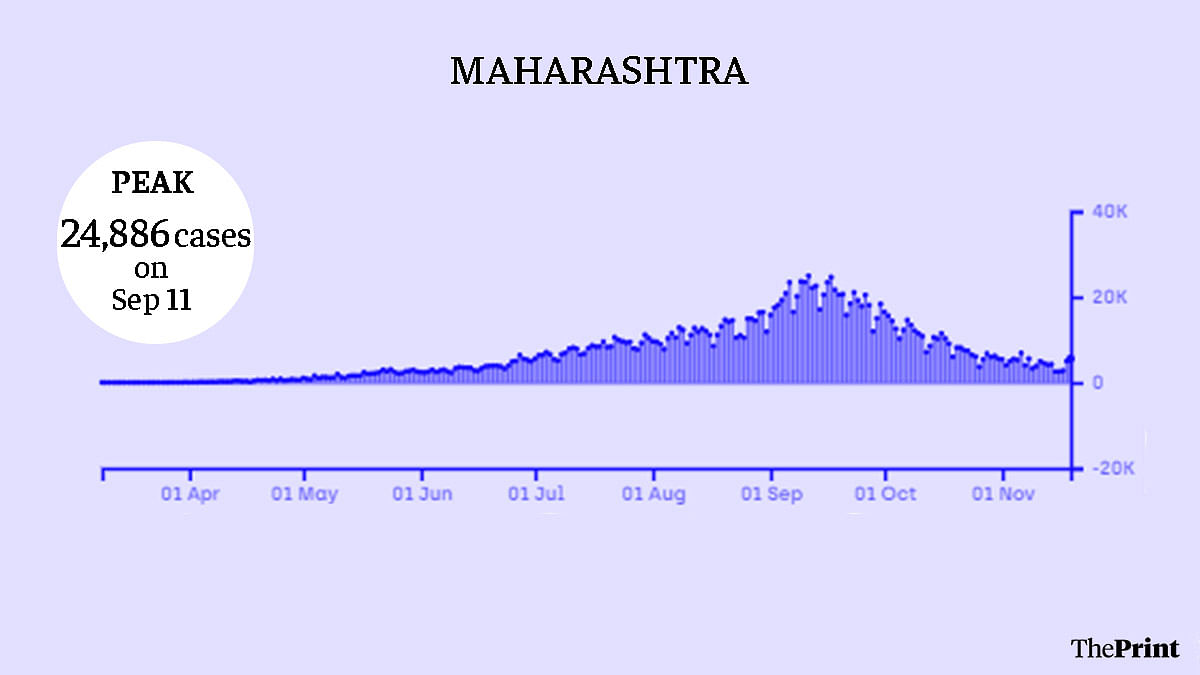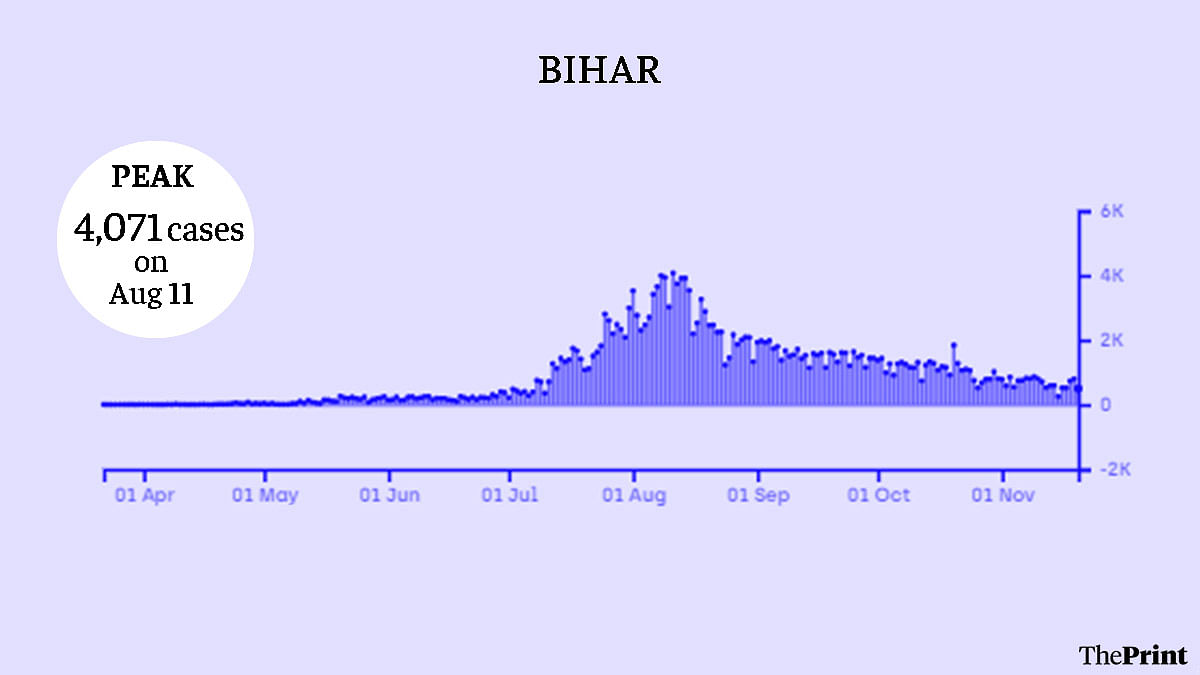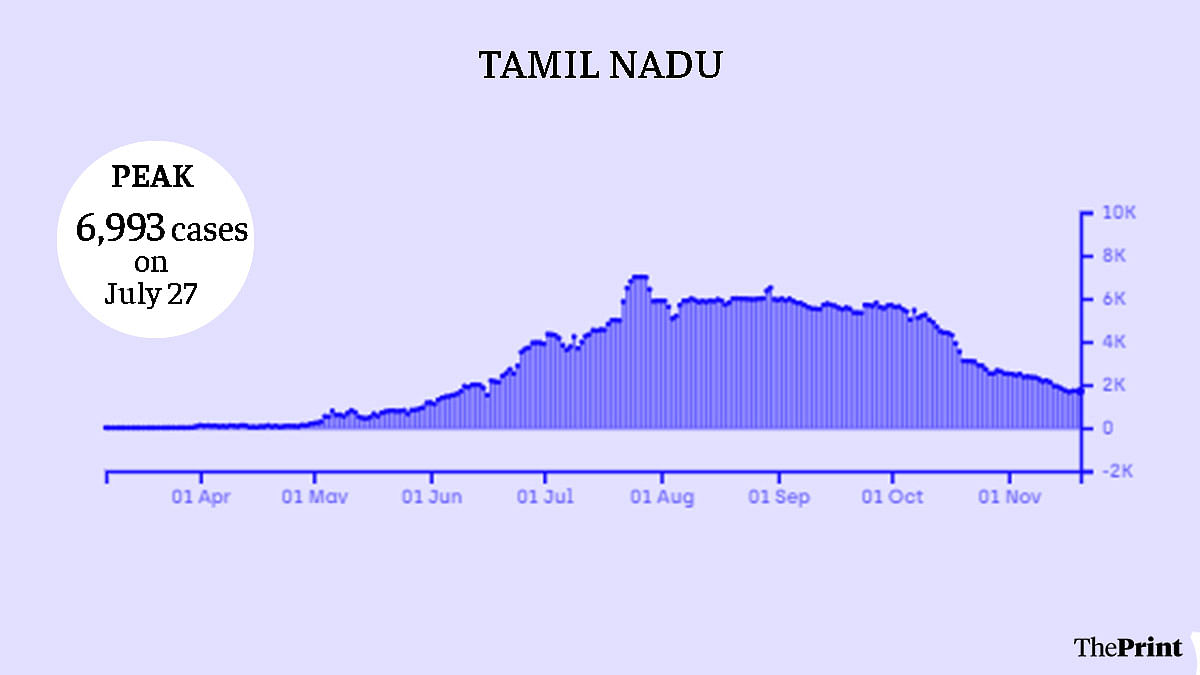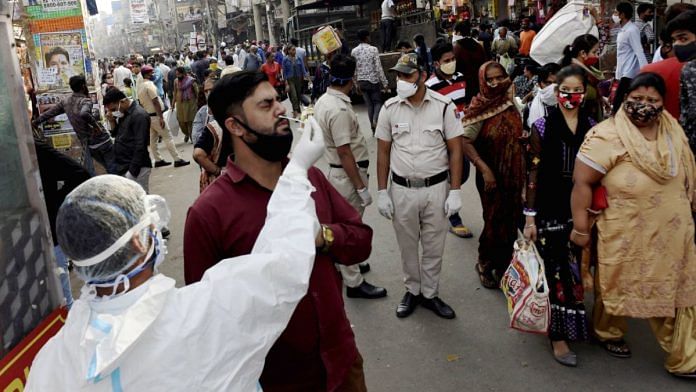New Delhi: For the past few weeks, Delhi has witnessed a massive unprecedented surge in Covid-19 cases and deaths. This comes even as India’s overall coronavirus graph has been on a decline since the country hit its peak, in terms of cases, mid-September.
While a spike in cases was expected with the onset of winter, air pollution and the festive season — Delhi’s current Covid situation was not anticipated. Cases began to rise in the national capital at the end of October and the city hit its third peak on 11 November with 8,593 cases — the highest number of daily cases registered in Delhi since the beginning of the pandemic.
Meanwhile, most big states that had been struggling with their Covid numbers initially have managed to keep them under control during this time. States like Maharashtra, Tamil Nadu, Kerala, Uttar Pradesh and Bihar have managed to turn the tide and reduce overall cases.
While officials from these states told ThePrint that it is still too early to determine if the effect of Diwali and lowering temperatures will alter the shape of their Covid graphs, here is how these states managed to get their numbers under control.
Also read: Slow testing, poor contact tracing led to surge in Covid cases, says parliamentary panel
Maharashtra
Maharashtra is the worst-affected state in the country in terms of total cases as well as active caseload. It makes up approximately 18 per cent of the total active cases in India and has reported 17,80,208 cases till date.
Maharashtra’s cases have been on decline since mid-September after it hit its peak on 11 September with 24,886 and a positivity rate of 25 per cent. Positivity rate refers to the rate of people who are positive out of the total tests conducted.
The rate has since dropped to 6.2 per cent, as of Monday, and the state reported 5,753 cases against 92,556 tests in the past 24 hours.
“The biggest thing that helped was a scheme we launched called ‘My Family My Responsibility,’ where surveillance teams visited more than 2 crore houses twice between September and October to conduct screenings, just before winter and Diwali,” Dr Pradeep Awate, State Surveillance Officer, told ThePrint.
“That gave us the opportunity to persuade people to stay vigilant. The fact that we visited each house twice also reinforced the message,” he added.
Maharashtra has also been cautious about lifting restrictions on people’s movement. Religious places were opened as late as 16 November in the state.
“We’ve asked the district corporations to focus on super spreaders, those who have more social contacts and act as a catalyst to disease spread. We are also focusing on comorbid people,” said Awate, adding, “We have an Information Bureau which has continuously sent out messages about Covid appropriate behaviour as well.”

Uttar Pradesh
At the height of its Covid-19 peak, Uttar Pradesh saw 7,016 cases on 11 September. Since then, the number of cases has come down significantly, with 2,557 cases registered Sunday. State authorities note that the decrease in cases is due to strict surveillance and testing.
“We are doing focused sampling for surveillance. If a patient has SARI (severe acute respiratory infection) symptoms and their antigen test is negative, we do an RT-PCR sample right away. We are also doing regular Zoom meetings with district officials and market heads to manage the situation,” said D.S. Negi, Director of Health Services in the state.
Uttar Pradesh has seen a total of 5,26,780 positive cases so far.
Negi added: “Our triaging is also strong. If you test them and someone turns out positive, we separate that person, either in the form of home isolation or hospitalisation, from the rest of the crowd as soon as possible.”
The state has conducted a substantial number of tests, testing a total of 1,79,85,811 samples since the pandemic began. This has put UP’s positivity rate at 2.9 per cent.
“We’ve become successful because we are testing a lot. Once you’re testing to the maximum, you’ll get more cases, and when you separate those patients and properly triage them, you reduce the chance of spread. We increase and decrease the number of tests depending on the cases,” said Negi.

Also read: ‘What if I test positive?’ — Fear at borders as Noida picks commuters for random Covid test
Kerala
While Kerala was seen as a model of Covid management during the initial days of the pandemic, the state added 1,41,924 cases in just over a month — from 22 August to 30 September after the 10-day Onam festival. The surge in cases continued till mid-October in the state, which has seen a total of 5,62,696 cases till date.
The most number of cases Kerala has seen in a day stands at 11,755 on 10 October.
While Kerala has the second-largest active caseload in the country, making up 15 per cent of the total active cases in India, its daily positives have been fluctuating between 9,000 and 3,000 and are decreasing as a whole. At the height of its peak, the state’s positivity rate was 17.4 per cent and Kerala has managed to bring it down to 10.9 per cent as of Monday.
“We have learned that controlling the virus doesn’t depend on testing, but on human behaviour. It depends on how good your information and communication is, and how compliant the man on the street is. Strategy needs to get into the mind and change behaviour — nothing else can make a bigger difference. All our media teams are helping us to do that,” Dr Amar Fettle, state nodal officer in Kerala, told ThePrint.
“There is always a gap with what we expect and what people do, but despite that we have been able to lower the positivity. An educated section will obey and comply. Often what we do to push people to comply is to consider their family members,” Fettle added.

Bihar
Bihar has, surprisingly, registered a low rate of infections. The state has recorded only 2,30,632 cases till 22 November, hitting its peak on 11 August with 4,071 daily cases. Since then, the number of daily positives has gone down significantly with 385 cases recorded in the last 24 hours.
“The three rules are testing, tracking and treating. These are the three things we followed,” Ragini Mishra, the state Covid officer, told ThePrint.
“We are also doing daily follow up for home isolation cases. Hospitalisation is stagnant. The bed occupancy rate is 1 to 2 per cent, majority of the positive cases are in home isolation and they are being tracked daily by agencies and symptomatic cases are being referred to health centres,” said Mishra.
Bihar is also a big contributor to India’s overall testing numbers, having collected 1,36,37,477 samples so far. The state also has one of the lowest positivity rates in the country — just 0.4 per cent as of Monday.

Tamil Nadu
Tamil Nadu has achieved a near perfect bell-shaped curve. The state’s cases peaked on 27 July with 6,993 cases, plateaued in August and then finally dropped in October. It has recorded a total of 7,69,995 cases since the pandemic began.
Most notably, Tamil Nadu decided not to use rapid antigen tests during its surveillance, relying entirely on the gold-standard RT-PCR test to ensure that detection is accurate.
Since September, the daily samples collected for testing have also remained high, between 60,000 and 90,000 per day. As of 22 November, Tamil Nadu has a positivity rate of 2.3 per cent, a decrease from 11.2 per cent at its peak.
“In Tamil Nadu, things were contained through lots of testing. Advising people on Covid-appropriate behaviour has also helped,” Dr Manoj Murhekar, director of the National Institute of Epidemiology, Chennai, told ThePrint.
Health Secretary Dr J. Radhakrishnan told NDTV in an interview, “What we also did was set up lots of fever camps in buffer zones and other workplaces. Our health experts have also advised that we start treatment early, and that is one of the reasons why our comorbid-related deaths were initially very high and have significantly come down.”

Also read: Ahmedabad under weekend-long & indefinite night curfews as cases surge after Navratri-Diwali



